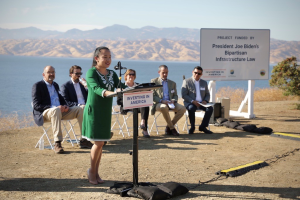Project aims to increase operational flexibility at key storage facility
 San Luis Reservoir is a key Central Valley Project storage facility
San Luis Reservoir is a key Central Valley Project storage facility
Among the many components of the Central Valley Project, San Luis Reservoir plays a key role in providing irrigation water to one of the world’s most productive agricultural regions. Completed in 1967, San Luis is the largest off-stream reservoir in the country. It’s also the only CVP reservoir south of the Sacramento-San Joaquin Delta. At more than 2 million acre-feet of storage, it controls and moderates water distribution for water users within the CVP and the State Water Project.
But in the decades following the San Luis’ completion, the realities of California’s water supply outlook have changed dramatically. Harsh, multi-year droughts combined with increased regulatory oversight of Delta pumping activities have hampered the ability to move water to south of Delta water users.
It’s expected that regulatory changes, CVP operation, and the overall growth in surface water demand will increase reliance on San Luis Reservoir supplies in the future. In an environmental document released in October, Reclamation and its partner, the San Luis & Delta-Mendota Authority, say that “these conditions all contribute to a need for actions to improve water supply reliability and operational flexibility south of the Delta.”
That need is being addressed with a $1 billion project that authorizes a 10-foot raise of the B.F. Sisk Dam that contains San Luis Reservoir. The raise dovetails with the 10-foot raise that’s part of a multi-year dam safety project that began in 2022. In all, the extra space will provide 130,000 acre-feet of additional water in the reservoir.
“When the reservoir expansion is complete, our Central Valley Project water contractors south of the Delta will have a much greater capability of storing water during wet years for the drier years that we know will come,” said Reclamation Regional Director Ernest Conant.
The reservoir expansion project is a significant milestone in the history of San Luis. It’s a noteworthy undertaking that aims to smooth the extreme climate swings in which severe drought is followed by extraordinarily wet episodes that test the capability of the flood management apparatus.
For Reclamation’s Principal Deputy Regional Director Richard Welsh, soon headed to retirement, the project closes a direct involvement with San Luis that started more than 60 years ago when his father, Robert, worked on the original project as a young engineer just out of college.

Welsh managed an integrated team of Reclamation staff and coordinated with the Water Authority during the planning, environmental, and engineering activities for the expansion project. The reservoir expansion project is being funded by Reclamation and the San Luis and Delta Mendota Water Authority, the 27-member organization comprised of agencies that deliver the irrigation water to land on the west side of the San Joaquin Valley.
The exact specifics of how the costs are shared are still to be determined. Reclamation is funding its portion via the Water Infrastructure Improvements for the Nation Act and the Bipartisan Infrastructure Law of 2021.

“Reclamation has been an indispensable component toward enabling investment in the project,” said Federico Barajas, executive director of the Authority.
While the 130,000 acre-feet provided by the reservoir expansion isn’t especially large, it is a “pretty significant amount when you are e in the middle of a drought with a zero percent allocation,” said Barajas, adding that the extra water “translates to a tangible benefit.”
Others believe the project makes sense in an era of whiplash weather events. The additional storage “will inject sorely needed operational flexibility” on both sides of the hydrological cycle, wrote Justin Fredrickson with the California Farm Bureau Federation in a comment letter regarding the project.
“On the one hand, it will create new spill-protected carry over, rescheduled water, transfer water, and dry-year reserve space to serve as a buffer against future droughts,” he wrote. “On the other hand, the same space will also better capture excess flows in wet years. Both of these operational features will help to smooth some of the year-to-year water supply volatility of recent years and, in turn, help restore certainty and reliability lost over roughly the last two decades.”
Work would commence during the final stages of the safety of dams project in September 2025 and is expected to be completed within six years.


